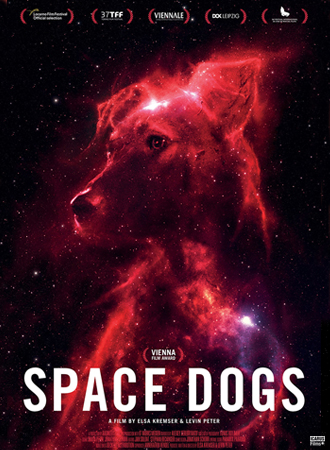
Space Dogs 2019
Distributed by Icarus Films, 32 Court St., 21st Floor, Brooklyn, NY 11201; 800-876-1710
Produced by Elsa Kremser and Levin Peter
Directed by Elsa Kremser and Levin Peter
Streaming, 91 mins
College - General Adult
Aerospace; Animal Biography; Russian History
Date Entered: 01/11/2021
Reviewed by Dorothy Ogdon, Emerging Technologies Librarian, University of Alabama at BirminghamSpace Dogs juxtaposes extensive footage of the life of street dogs in Moscow with a narrative thread focused on the experiences of animals used in the early development of spaceflight in both the USSR and the United States. The film consists of contemporary footage, presumably from the streets of Moscow, interspersed with archival footage of spaceflight and dogs being used in research activities in support of spaceflight.
The tone of Space Dogs is reflective and melancholy. The primary structure in the film is provided by sparse Russian narration, though the film is subtitled and will be accessible to English-reading or Russian-speaking audiences. Though well-written, the narration provides a setting for the footage being shown and little else, leaving the viewer to draw their own conclusions about much of the content. The film focuses on the lives of stray dogs in Moscow, framed by stories about Laika, the first dog in space, as well as other animals including chimpanzees, dogs, and turtles used in preparation for human spaceflight. The film is atmospheric, rather than informational in nature. While it does contain brief touchpoints for the viewer related to the experiences of Laika and other spacefaring animals, it is not well suited as a documentary to provide structured background or historical information on animal experimentation in the early development of aerospace technology. Instead, the film’s strengths lie in its use of the dogs’, rather than human, point-of-view, its unvarnished presentation of the behaviors of stray dogs, and its unflinching look at the conflicted nature of the trust-based relationships humans establish with animals while also subjecting them to stress and potential destruction. There are more canine than human faces in this movie, though the implications of this choice are not directly addressed, giving the audience the freedom to explore a wide range of nuanced viewpoints on animal-human relationships in non-domestic settings.
The film would be of interest to anyone examining non-American viewpoints on ethics and the treatment of animals, animal and particularly canine behavior, and cultural values related to public spaces and the presence of stray animals. Space Dogs will also be of interest for Russian language cultural studies. Potential viewers should exercise some caution before including this film in a curriculum or in a public viewing as it includes material that may be considered graphic in nature. Contemporary footage of street dogs includes a range of canine behaviors such as aggression between individual animals and a housecat being killed by a street dog. Archival footage in this film shows dogs being secured and spun in a centrifuge as well as surgical procedures being performed on conscious animals.
Awards:
Best Austrian Film, Viennale 2019; Extra Value Film Award, Viennale 2019; Jury Award, FIDOCS Documentary Festival 2019; Special Mention, Locarno Film Festival 2019; Best Cinematography, DIAGONALE’20 2019
Published and licensed under the Creative Commons Attribution 4.0 license. Anyone can use these reviews, so long as they comply with the terms of the license.